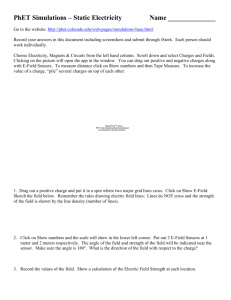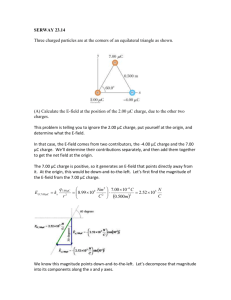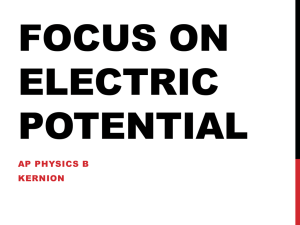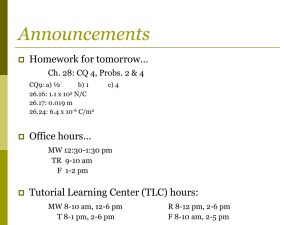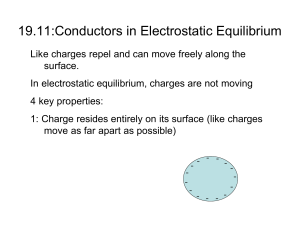Lab 1: Electric Fields and Gauss’s Law
advertisement
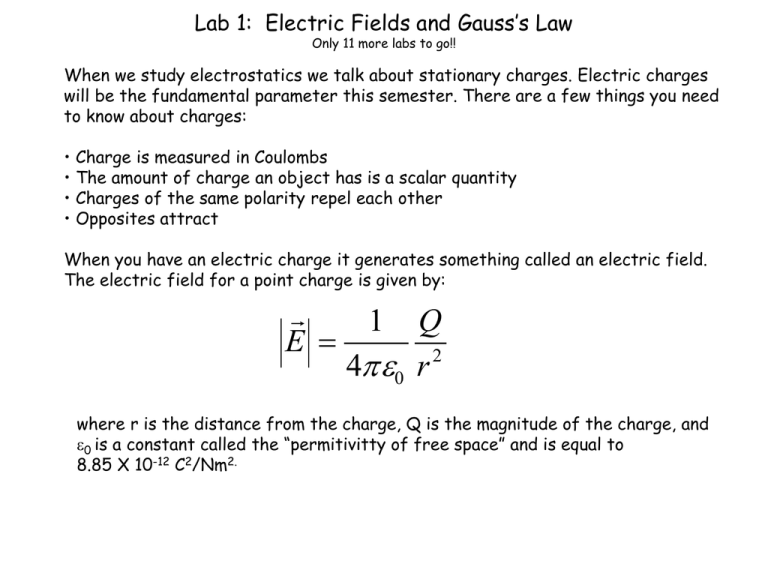
Lab 1: Electric Fields and Gauss’s Law Only 11 more labs to go!! When we study electrostatics we talk about stationary charges. Electric charges will be the fundamental parameter this semester. There are a few things you need to know about charges: • • • • Charge is measured in Coulombs The amount of charge an object has is a scalar quantity Charges of the same polarity repel each other Opposites attract When you have an electric charge it generates something called an electric field. The electric field for a point charge is given by: E 1 Q 2 40 r where r is the distance from the charge, Q is the magnitude of the charge, and 0 is a constant called the “permitivitty of free space” and is equal to 8.85 X 10-12 C2/Nm2. Things you need to know about electric fields: (what is a “field”) • Vector quantity has both magnitude and direction • Units of E-field N/C Electric field lines originate from positive charges + Electric field lines terminate at negative charges: - The electric field lines are more dense where the E-field is greater What if we have a configuration of charges, how do the E-field lines look? + - If you have a stationary charge (Q1) and bring another charge (Q2) into the picture Q2 will encounter a force due to Q1. The force is related to the electric field setup by Q1. F2 Q2 E1 F E-field +Q2 F E-field F +Q2 +Q1 +Q2 F E-field +Q2 E-field F2 Q2 E1 What if Q1 is negative? F E-field +Q2 F E-field F +Q2 -Q1 +Q2 +Q2 F E-field E-field Let’s look at this situation: How much work will I do in moving charge +qo from point B to point A A B FApp +Q +q FApp d Fd cos o WB A For this situation equals zero, so the cos term equals one and the necessary work becomes: WB A Fd When we talk about electricity we talk about electric potential, this is similar to gravitational potential energy. Electric potential is defined as: W V qo remember that for our situation W = Fd so the electric potential becomes: Fd V qo Also recall that the force experienced by a charge in an electric field is given by: F qo E So the electric potential becomes: qo E d V E d qo So the electric field becomes: V E d E-field Equipotential Surfaces: Electric potential contours, depicts areas of the same potential The electric field lines are perpendicular to the equipotential surfaces. E-field V1 V2 E-field E-field Today we will be drawing equipotential and electric field lines for different geometries. + - Equipotential Lines E-Field Lines - Equipotential Lines E-Field Lines + + Equipotential Lines E-Field Lines - 2 V, 1 cm 4 V, 3.1 cm 8 V, 7.8 cm Next plot Voltage on the y-axis and position on the x-axis

